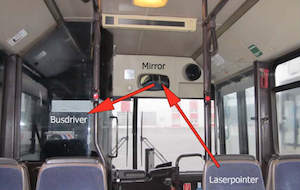Home
A comprehensive resource for safe and responsible laser use
Germany: Bus driver's eye injured by laser pointer aimed by child
An October 5 2015 report in the British Medical Journal Case Reports describes a public bus driver who suffered retinal injury due to a schoolboy aiming a red laser beam into a mirror on the bus, reflecting into the driver’s eyes.

The 44-year-old driver stared into the laser several times, as he tried to identify the person holding the laser. He suffered blurred vision in his right eye immediately after the exposure, but waited 6 months before having his first complete eye exam.
The exam showed “spot-like retinal pigment epithelium disturbances temporal to the fovea of the right eye, with no abnormalities in his left eye.” The authors stated that “The subjective complaints and objective ophthalmological findings of this patient were consistent and strongly suggested that the repetitive exposure of the eye to the reflected laser spot 6 months previously had caused subtle but detectable injury to the macula.”
The authors concluded with two “Learning points”:
The authors did not identify the location of the incident, but it may be Germany since three of the four authors’ institutions were in Germany. Additional analysis and commentary is below (click the “Read More…” link).
From Thanos S, Böhm MRR, Meyer zu Hörste M, et al. “Retinal damage induced by mirror-reflected light from a laser pointer” BMJ Case Reports. Retrieved online: 2015 Nov 05, doi:10.1136/bcr-2015- 210311.

The 44-year-old driver stared into the laser several times, as he tried to identify the person holding the laser. He suffered blurred vision in his right eye immediately after the exposure, but waited 6 months before having his first complete eye exam.
The exam showed “spot-like retinal pigment epithelium disturbances temporal to the fovea of the right eye, with no abnormalities in his left eye.” The authors stated that “The subjective complaints and objective ophthalmological findings of this patient were consistent and strongly suggested that the repetitive exposure of the eye to the reflected laser spot 6 months previously had caused subtle but detectable injury to the macula.”
The authors concluded with two “Learning points”:
- “We suggest that no laser pointers of any class are made available to children, since they are unlikely to understand the risks of permanent retinal damage.”
- “For the safety of users and the general public, even low-energy handheld laser pointers should not be sold to children.”
The authors did not identify the location of the incident, but it may be Germany since three of the four authors’ institutions were in Germany. Additional analysis and commentary is below (click the “Read More…” link).
From Thanos S, Böhm MRR, Meyer zu Hörste M, et al. “Retinal damage induced by mirror-reflected light from a laser pointer” BMJ Case Reports. Retrieved online: 2015 Nov 05, doi:10.1136/bcr-2015- 210311.
Analysis and commentary by LaserPointerSafety.com
The paper said the laser beam traveled 16.5 meters from the laser to the driver’s eyes. What type of laser could cause retinal damage at that distance, under the conditions specified?
The authors stated that “[a]lthough the exact energy of the handheld laser pointer was not determined, the descriptions and reports of those involved suggested that it was a class II or class 3R laser device (1 or 5 mW)…. The subject reported that the laser beam was red, and so it was most likely a handheld laser pointer emitting at a wavelength of around 650 nm. The divergence of the laser beam from such a device is about 1 mrad.”
According to Skyzan laser safety software, a 5 milliwatt laser with 1 mm beam diameter and 1 milliradian divergence has a Nominal Ocular Hazard Distance (NOHD) of 15.8 meters, for an accidental exposure time of 0.25 seconds (generally agreed to be the time by which an uncooperative subject will blink and/or look away from the laser). Based on this, the laser would be highly unlikely to cause any injury — the driver’s eye was outside the hazard distance.
The report said “the bus driver had looked at least three or four times into the mirror in order to locate the laser source, implying that he had received a minimum of least 10 s of cumulative exposure to the laser beam.” In such a case, the driver was deliberately overriding his 0.25 second aversion response.
Skyzan shows an NOHD of 25.2 meters for a continuous exposure of 10 seconds. This means the driver was within the NOHD, and thus there is potential for injury. At a distance of about 1/3 the NOHD, or about 8 meters, there would be roughly a 50/50 chance of the minimally detectable eye injury, in cases where the laser and eye are fixed in position such as in a laboratory. Since the driver’s eye was twice as far as this distance, the laser was not on for 10 full seconds, and both the eye and laser were moving relative to each other, the likelihood of damage would be lessened.
The exam did show relatively “subtle” and “barely visible” changes to the driver’s right eye. Laser eye injury is to some extent probabilistic — an exposure that causes changes in one subject’s eye may not do anything to another subject. It may be that the laser was more powerful than 5 mW, that the beam was more tightly focused than 1 mrad divergence, that the driver looked at the laser longer than he thought, or simply that the driver’s retina was more susceptible to being injured.
Since the laser pointer was not recovered or examined, we will never know the true nature of the beam that struck the driver.